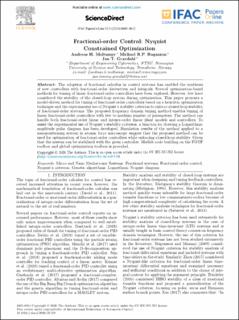| dc.contributor.author | Moltumyr, Andreas Hanssen | |
| dc.contributor.author | Ragazzon, Michael Remo Palmén | |
| dc.contributor.author | Gravdahl, Jan Tommy | |
| dc.date.accessioned | 2021-09-10T07:00:43Z | |
| dc.date.available | 2021-09-10T07:00:43Z | |
| dc.date.created | 2021-01-11T15:35:25Z | |
| dc.date.issued | 2020 | |
| dc.identifier.issn | 2405-8963 | |
| dc.identifier.uri | https://hdl.handle.net/11250/2775098 | |
| dc.description.abstract | The adoption of fractional calculus in control systems has enabled the synthesis of new controllers with fractional-order derivatives and integrals. Several optimization-based methods for tuning of linear fractional-order controllers have been explored. However, few have considered the stability of the closed-loop system during optimization. This paper presents a model-driven method for tuning of fractional-order controllers based on a heuristic optimization technique and the experimental use of Nyquist’s stability criterion to enforce closed-loop stability of fractional-order systems. The proposed frequency domain tuning method enables tuning of linear fractional-order controllers with few to medium number of parameters. The method can handle both fractional-order linear and integer-order linear plant models and controllers. To assist the experimental use of Nyquist’s stability criterion, a function for drawing a Logarithmic amplitude polar diagram has been developed. Simulation results of the method applied to a nanopositioning system in atomic force microscopy suggest that the proposed method can be used for optimization of fractional-order controllers while enforcing closed-loop stability. Given that the system can be stabilized with the given controller. Matlab code building on the FOTF toolbox and global optimization toolbox is provided. | en_US |
| dc.language.iso | eng | en_US |
| dc.publisher | International Federation of Automatic Control (IFAC) | en_US |
| dc.rights | Attribution-NonCommercial-NoDerivatives 4.0 Internasjonal | * |
| dc.rights.uri | http://creativecommons.org/licenses/by-nc-nd/4.0/deed.no | * |
| dc.title | Fractional-order Control: Nyquist Constrained Optimization | en_US |
| dc.type | Peer reviewed | en_US |
| dc.type | Journal article | en_US |
| dc.description.version | publishedVersion | en_US |
| dc.source.journal | IFAC-PapersOnLine | en_US |
| dc.identifier.doi | https://doi.org/10.1016/j.ifacol.2020.12.519 | |
| dc.identifier.cristin | 1869214 | |
| dc.relation.project | Norges forskningsråd: 237900 | en_US |
| cristin.ispublished | true | |
| cristin.fulltext | postprint | |
| cristin.qualitycode | 1 | |

